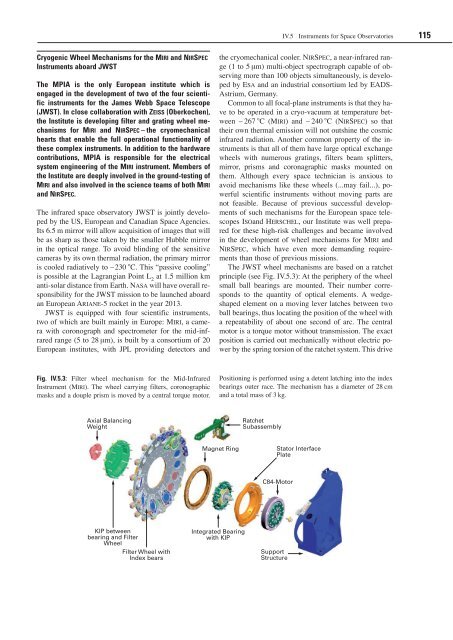Max Planck Institute for Astronomy - Annual Report 2007
Max Planck Institute for Astronomy - Annual Report 2007
Max Planck Institute for Astronomy - Annual Report 2007
Create successful ePaper yourself
Turn your PDF publications into a flip-book with our unique Google optimized e-Paper software.
Cryogenic Wheel Mechanisms <strong>for</strong> the Miri and NirSpec<br />
Instruments aboard JWST<br />
The MPIA is the only European institute which is<br />
engaged in the development of two of the four scientific<br />
instruments <strong>for</strong> the James Webb Space Telescope<br />
(JWST). In close collaboration with ZeiSS (Oberkochen),<br />
the <strong>Institute</strong> is developing filter and grating wheel mechanisms<br />
<strong>for</strong> Miri and NirSpec – the cryomechanical<br />
hearts that enable the full operational functionality of<br />
these complex instruments. In addition to the hardware<br />
contributions, MPIA is responsible <strong>for</strong> the electrical<br />
system engineering of the Miri instrument. Members of<br />
the <strong>Institute</strong> are deeply involved in the ground-testing of<br />
Miri and also involved in the science teams of both Miri<br />
and NirSpec.<br />
The infrared space observatory JWST is jointly developed<br />
by the US, European and Canadian Space Agencies.<br />
Its 6.5 m mirror will allow acquisition of images that will<br />
be as sharp as those taken by the smaller Hubble mirror<br />
in the optical range. To avoid blinding of the sensitive<br />
cameras by its own thermal radiation, the primary mirror<br />
is cooled radiatively to –230 C. This “passive cooling”<br />
is possible at the Lagrangian Point L 2 at 1.5 million km<br />
anti-solar distance from Earth. Nasa will have overall responsibility<br />
<strong>for</strong> the JWST mission to be launched aboard<br />
an European ariaNe-5 rocket in the year 2013.<br />
JWST is equipped with four scientific instruments,<br />
two of which are built mainly in Europe: Miri, a camera<br />
with coronograph and spectrometer <strong>for</strong> the mid-infrared<br />
range (5 to 28 µm), is built by a consortium of 20<br />
European institutes, with JPL providing detectors and<br />
Fig. IV.5.3: Filter wheel mechanism <strong>for</strong> the Mid-Infrared<br />
Instrument (Miri). The wheel carrying filters, coronographic<br />
masks and a douple prism is moved by a central torque motor.<br />
Axial Balancing<br />
Weight<br />
KIP between<br />
bearing and Filter<br />
Wheel<br />
Filter Wheel with<br />
Index bears<br />
IV.5 Instruments <strong>for</strong> Space Observatories 115<br />
the cryomechanical cooler. Nirspec, a near-infrared range<br />
(1 to 5 µm) multi-object spectrograph capable of observing<br />
more than 100 objects simultaneously, is developed<br />
by esa and an industrial consortium led by EADS-<br />
Astrium, Germany.<br />
Common to all focal-plane instruments is that they have<br />
to be operated in a cryo-vacuum at temperature between<br />
– 267 C (Miri) and – 240 C (Nirspec) so that<br />
their own thermal emission will not outshine the cosmic<br />
infrared radiation. Another common property of the instruments<br />
is that all of them have large optical exchange<br />
wheels with numerous gratings, filters beam splitters,<br />
mirror, prisms and coronagraphic masks mounted on<br />
them. Although every space technician is anxious to<br />
avoid mechanisms like these wheels (...may fail...), powerful<br />
scientific instruments without moving parts are<br />
not feasible. Because of previous successful developments<br />
of such mechanisms <strong>for</strong> the European space telescopes<br />
isoand HerscHel, our <strong>Institute</strong> was well prepared<br />
<strong>for</strong> these high-risk challenges and became involved<br />
in the development of wheel mechanisms <strong>for</strong> Miri and<br />
Nirspec, which have even more demanding requirements<br />
than those of previous missions.<br />
The JWST wheel mechanisms are based on a ratchet<br />
principle (see Fig. IV.5.3): At the periphery of the wheel<br />
small ball bearings are mounted. Their number corresponds<br />
to the quantity of optical elements. A wedgeshaped<br />
element on a moving lever latches between two<br />
ball bearings, thus locating the position of the wheel with<br />
a repeatability of about one second of arc. The central<br />
motor is a torque motor without transmission. The exact<br />
position is carried out mechanically without electric power<br />
by the spring torsion of the ratchet system. This drive<br />
Positioning is per<strong>for</strong>med using a detent latching into the index<br />
bearings outer race. The mechanism has a diameter of 28 cm<br />
and a total mass of 3 kg.<br />
Magnet Ring<br />
Integrated Bearing<br />
with KIP<br />
Ratchet<br />
Subassembly<br />
Support<br />
Structure<br />
Stator Interface<br />
Plate<br />
C84-Motor

















